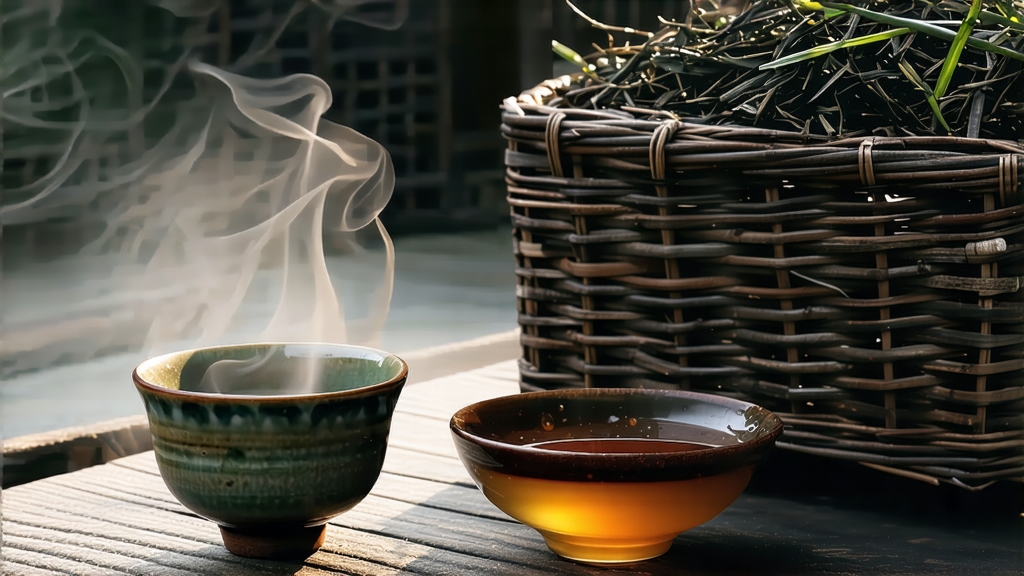
Tucked away in the subtropical mountains of southern China’s Guangxi Zhuang Autonomous Region, Liu Bao tea has spent four centuries quietly perfecting the art of transformation. To the uninitiated it is merely another dark brick among the vast family of Chinese hei cha (黑茶, literally “black tea”), yet to the seasoned palate Liu Bao is a liquid archive of caravan bells, river mists, and the micro-flora that once accompanied tea on month-long voyages to Southeast Asia. This article invites the international reader to journey through Liu Bao’s history, terroir, craftsmanship, and the ritual of coaxing its signature betel-nut fragrance into a glowing cup.
-
From Frontier Currency to Maritime Treasure
Liu Bao takes its name from the old trading post of Liu Bao township in Wuzhou prefecture, where the Liu River meets the Xi River and flows onward to the Pearl River Delta. During the late Ming dynasty (17th c.), pressed tea was accepted as tax-in-kind from mountain tribes; by the Qing, Liu Bao had become one of the “Three Famous Teas of Guangxi” exchanged for horses on the Tea-Horse Road. When British and Dutch clipper ships began calling at Guangzhou, Liu Bao was re-packed into 50 kg bamboo baskets, steamed to tighten, and lashed below deck. The humid hold, swaying for 30–40 days to Singapore or Jakarta, acted as an accidental “wet storage,” accelerating fermentation and imprinting a mellow, earthy sweetness that Malay miners swore could prevent malaria. Thus a tea born for mule caravans found a second life as the breakfast drink of Southeast Asian dockworkers, a legacy still visible in Kuala Lumpur’s old kopitiam clocks that read “Liu Bao” in faded Chinese calligraphy. -
Terroir: Where Granite Meets the Tropic
The protected geographical indication restricts Liu Bao leaf to the limestone-karst foothills of Cangwu, Tengxian, and Lipu counties at 200–800 m elevation. Here lateritic soil, rich in iron and potassium, drains rapidly after the region’s 1,600 mm annual rainfall. The indigenous cultivar is the medium-leaf “Yunnan Daye” transplant, locally called “Zhong ye zhong,” prized for thick cell walls that withstand repeated pile-turning without collapsing. Spring morning fog slows photosynthesis, raising theanine, while the intense subtropical sun of late summer spikes polyphenols—an ideal chemical tension that will later yield both sweetness and deep color under microbial action. -
Craftsmanship: The Double Dance of Heat and Humidity
Liu Bao shares the broad outline of hei cha processing—kill-green, rolling, pile-fermentation, drying, sorting, compression, and aging—but each step carries a Guangxi accent.
a) Kill-green at 280 °C for 3–4 min in a 1 m diameter wok deactivates 80 % of oxidative enzymes while preserving surface microbes.
b) Rolling is done in three short bursts (light-heavy-light) to fracture 60 % of cells, enough to release sap for microbial feedstock yet keep leaves intact for repeated infusions.
c) Primary pile-fermentation (dui wei) lasts 10–12 h at 55–60 °C, shorter than Anhua Fu Brick’s 20 h, producing a golden-yellow leaf rim rather than chocolate brown.
d) The signature secondary “wet piling” (jin hou) follows: leaves are sprayed with Wuzhou’s mineral-rich river water (pH 7.2), heaped 70 cm high, and covered with jute. Over 25–30 days internal temperatures oscillate between 45 °C and 52 °C; thermophilic Aspergillus niger and Blastobotrys adeninivorans bloom, converting catechins into theabrownins and creating Liu Bao’s hallmark “betel-nut” note—an aroma somewhere between nutmeg, camphor, and dried longan.
e) After drying on bamboo racks above pine-charcoal embers, the leaf is sorted into five grades (te ji, 1–4) based on stalk ratio and leaf integrity.
f) Compression into 40–50 kg bamboo baskets (lóng) lined with untreated banana leaf allows micro-oxygenation. Seven concentric rings of hand-twisted bamboo strap tighten the basket